Hibiscus Mutabilis (Confederate Rose) Grow & Care Guide
Written by Iris
Feb 10 2023
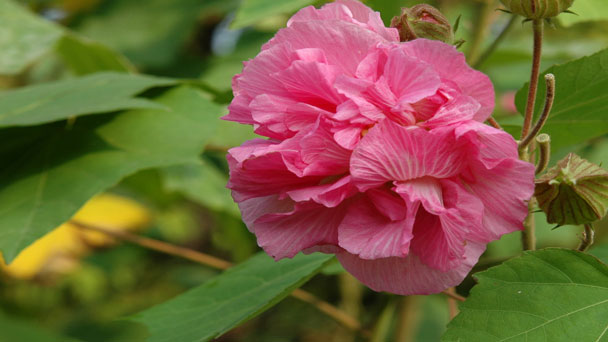
The changeable color is a major feature of Hibiscus mutabilis (Confederate Rose). We can often see white flowers, pink flowers, and the crimson red flowers when it first bloomed on a tree. This kind of scenery is both strange and interesting. Hibiscus mutabilis is mostly cultivated in gardens. It can be planted in clusters by walls, roadsides, or planted in sloping fields, or by water. The flowers are reflected in the waves and the scenery is charming. Hibiscus mutabilis has strong adaptability and can be planted along railways, highways, ditches, and can also be potted for viewing. It is a widely used greening tree species.
Seed - sow early spring in a warm greenhouse. Germination is usually fairly rapid. Prick out the seedlings into individual pots when they are large enough to handle. If growing Hibiscus Mutabilis as annuals, plant them out into their permanent positions in early summer and protect them with a frame or cloche until they are growing away well. If hoping to grow them as perennials, then it is better to grow them on in the greenhouse for their first year and to plant them out in early summer of the following year.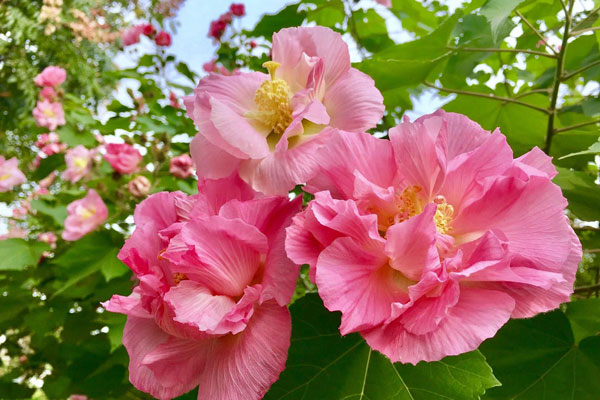
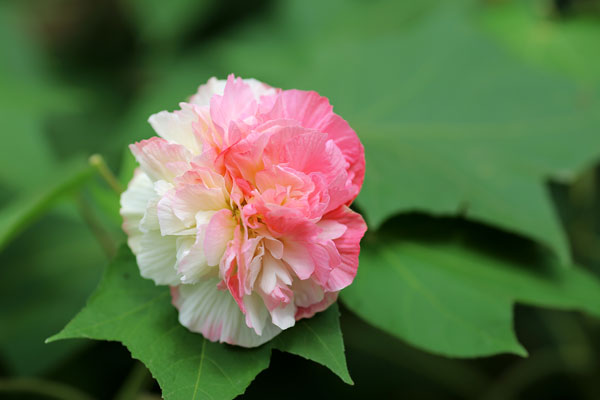
TIP: You can prevent spider mites, whiteflies and hibiscus aphid attacks from taking hold by spraying the plant thoroughly with plain water once a week early in the morning.
Hibiscus Mutabilis is also prone to Southern Stem Blight and leaf spot. Examine the leaves frequently for brown circles. Also look for brown lesions on the stems and at the plant’s base adjacent to the soil line. You can prevent Southern Stem Blight from taking hold by making sure that mulch applied around the plants does not touch the stems. For both of these maladies, application of a fungicide is appropriate; however, it's best to avoid fungal growth by allowing plenty of room between plants for good air circulation and avoid overhead watering.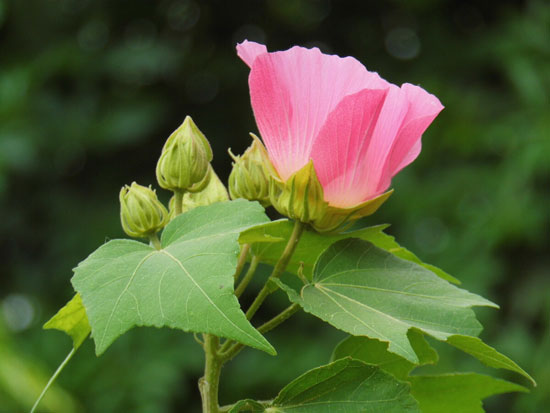
Blue Bird: Produces a stunning blue shade of flowers; grows 3-4 feet tall when planted in full sun
Rose of Sharon: Blooms from late summer to mid-fall in colors including purple, white, and violet colors with sharp, oval-shaped leaves
China Rose: A shrub that's used for shoe polishing in the tropics; produces red flowers along with orange, pink, yellow single, and double-petaled blossoms.
Perfect Storm: Big, bi-colored flowers with reddish-pink centers; foliage becomes a very dark purple (can almost appear black)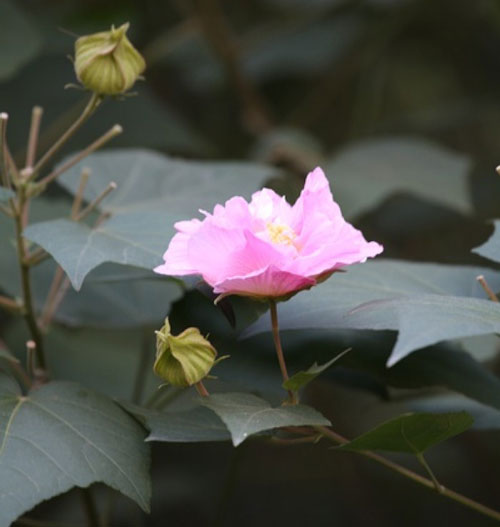
How to Grow Hibiscus Mutabilis (Confederate Rose)Hibiscus Mutabilis Propagation with SeedsHibiscus Mutabilis Propagation with Stem CuttingsHow to Care for Hibiscus Mutabilis (Confederate Rose)Lighting RequirementsSoil CareWateringTemperature & Humidity CareFertilizerPruningPests & Diseases CareVarieties of Hibiscus Mutabilis (Confederate Rose)Hibiscus Mutabilis (Confederate Rose) FAQIs The Hibiscus Plant Considered Toxic or Poisonous?Is The Hibiscus Rose Invasive?
How to Grow Hibiscus Mutabilis (Confederate Rose)
Hibiscus Mutabilis Propagation with Seeds
You can propagate the Hibiscus Mutabilis plant by seed sown in early spring. Alternately, you can take cuttings during the summertime.As the flowers fade, they transition into brittle seed capsules. It is easy to collect the seeds, save them and plant them in the springtime.Seed - sow early spring in a warm greenhouse. Germination is usually fairly rapid. Prick out the seedlings into individual pots when they are large enough to handle. If growing Hibiscus Mutabilis as annuals, plant them out into their permanent positions in early summer and protect them with a frame or cloche until they are growing away well. If hoping to grow them as perennials, then it is better to grow them on in the greenhouse for their first year and to plant them out in early summer of the following year.
Hibiscus Mutabilis Propagation with Stem Cuttings
Another way that you can do to propagate hibiscus mutabilis plant is to take cuttings during the summertime. The cuttings root quickly with minimal care or preparation and will produce a transplant-ready shrub by the following summer.- Prepare a rooting pot before gathering the Confederate rose cuttings. Fill a 1-gallon nursery container with a mixture of 4 parts medium-grit sand and 1 part perlite.
- Run a garden hose into the container until the sand and perlite mixture is thoroughly saturated. Let the excess water drain off for approximately one hour before potting the cuttings.
- Gather a 12- to 18-inch-long hardwood cutting from the base of a healthy Confederate rose stem. Choose a cutting with a thickness comparable to a pencil. Sever the cutting with pruning shears just beneath a leaf node.
- Trim the severed end of the cutting at a 45-degree angle to expose a larger surface area of the cambium, or inner bark, because it contains the highest concentration of growth-producing meristematic cells.
- Insert the angled end of the Confederate rose cutting into the moistened sand mixture. Press it in until the bottom half of the cutting is buried. Press the sand in against the stem.
- Place the nursery container inside a cold frame or against a sheltered, south-facing wall. Prop a clear plastic bag over the cutting if you are rooting it outside.
- Water the Hibiscus Mutabilis cutting whenever the sand feels mostly dry in the top 4 inches. Drizzle water around the base until the sand feels somewhat saturated just below the surface.
- Test for roots in four to six weeks by tugging gently on the base of the stem. Grow the cutting in its rooting pot until it shows obvious signs of growth such as leaf production.
- Transfer the Hibiscus Mutabilis into a 1-gallon container filled with potting soil once it produces leaves. Grow it under lightly shaded conditions for the first few weeks, then gradually acclimate it to full sun.
- Transplant the Hibiscus Mutabilis into a sunny bed with well-draining soil in late summer. Space multiple shrubs 10 feet apart. Spread a 2-inch-thick layer of mulch around the base of each to protect the roots while they establish.

How to Care for Hibiscus Mutabilis (Confederate Rose)
Lighting Requirements
Hibiscus Mutabilis plant can grow best if it is exposed to full sun, but part shade can also be tolerated. If you put this plant in an area with more sun, make sure that you have to water it more often. According to Best Plants, this plant is hardy to USDA Hardiness zones 7 through 10. In Zones 9 and 10, it can grow quite splendidly. In zones 7 to 8, it will die back after the first freeze. However, if you can give it proper care, it will sprout vigorously in the next spring.Soil Care
Hibiscus mutabilis likes soil which is well-draining and loamy and also enriched with compost. The moisture of the soil is medium. To help maintain moisture of the soil, you are able to top dress the soil with a thick layer of organic mulch. However, it is important for you to be careful not to permit the mulch to come in direct contact with the stem of the plant because it can lead to mold and mildew issues.Watering
Hibiscus Mutabilis like water but do not let it stand with wet feet.The soil needs to dry up between watering to protect from root rot. Make certain no excess water remains in the planter half an hour after watering. Pay particularly attention to this for plants that are placed in a cool spot where the temperature stays below 60F (+16C).Temperature & Humidity Care
The hibiscus mutabilis is not a particularly cold-hardy plant; it can tolerate short periods with temperatures falling to about 23 degrees Fahrenheit when fully dormant. Its top growth will be killed by even slight frost, however, its roots are somewhat hardier. It's even possible for the plant to resprout after a few degrees of frost.Fertilizer
Since the Hibiscus mutabilis are sensitive to too much fertilizer, it is best to use a balanced time-release formula, such as 10-10-10 products. Apply fertilizer twice a month for best results, and be sure to read and follow the product label to understand the application details, dosage and time. Or, you can skip the fertilizer altogether, but the plant will grow much slower.
Pruning
Wait until winter before you begin pruning the Hibiscus Mutabilis. Unless you live in a climate that doesn't experience frosts, this perennial plant will lose its leaves, and many of the stems will die back on their own once winter rolls around. Use disinfected pruning shears to cut back any remaining stems to a height of several inches above the ground. New shoots will appear along the base of the plant in spring, and it won't take long after that for the plant to flourish as it did the previous summer.Pests & Diseases Care
As with most Hibiscus plants, Hibiscus Mutabilis can be plagued by Hibiscus spider mites, aphids, and whiteflies on Hibiscus. Be sure to check the undersides of the foliage frequently for these pests. As soon as you see them, spray the plant thoroughly with insecticidal soap. Make sure that the entire plant is soaked. It’s best to apply this product early in the morning to ensure that the plant is dry before nighttime. Being damp overnight could cause problems with powdery mildew.TIP: You can prevent spider mites, whiteflies and hibiscus aphid attacks from taking hold by spraying the plant thoroughly with plain water once a week early in the morning.
Hibiscus Mutabilis is also prone to Southern Stem Blight and leaf spot. Examine the leaves frequently for brown circles. Also look for brown lesions on the stems and at the plant’s base adjacent to the soil line. You can prevent Southern Stem Blight from taking hold by making sure that mulch applied around the plants does not touch the stems. For both of these maladies, application of a fungicide is appropriate; however, it's best to avoid fungal growth by allowing plenty of room between plants for good air circulation and avoid overhead watering.

Varieties of Hibiscus Mutabilis (Confederate Rose)
These hibiscus varieties share similar care requirements with the cotton rose, but offer something a little different in terms of bloom shades and shapes.Blue Bird: Produces a stunning blue shade of flowers; grows 3-4 feet tall when planted in full sun
Rose of Sharon: Blooms from late summer to mid-fall in colors including purple, white, and violet colors with sharp, oval-shaped leaves
China Rose: A shrub that's used for shoe polishing in the tropics; produces red flowers along with orange, pink, yellow single, and double-petaled blossoms.
Perfect Storm: Big, bi-colored flowers with reddish-pink centers; foliage becomes a very dark purple (can almost appear black)

Hibiscus Mutabilis (Confederate Rose) FAQ
Is The Hibiscus Plant Considered Toxic or Poisonous?
According to the American Society for the Prevention of Cruelty to Animals (ASPCA) members of the Malvaceae family are non-toxic to cats, dogs and horses. In fact, many types of Hibiscus are considered edible and are used to make tea, as a flavoring and as foodstuffs in China. Even so, you should not toss Hibiscus Mutabilis leaves and flowers into your salads willy-nilly. Different types of Hibiscus have different effects. If you want to experiment with adding Hibiscus of any sort to your diet, be sure to perform a thorough course of research before doing so.Is The Hibiscus Rose Invasive?
According to invasive.org, Hibiscus Mutabilis is not considered invasive in any part of North America.Latest Updated
- Texas Star Hibiscus Plants - How to Grow & Care for Scarlet Rosemallow
- Hibiscus Mutabilis (Confederate Rose) Grow & Care Guide
- Why Do My Hibiscus Leaves Turn Yellow - Should I Cut Off Them
- Peace Lily Root Rot - Signs & How to Treat
- Why Is My Peace Lily Not Blooming - Causes & How to Get Them Bloom
- How Long Do Peace Lilies Last - How to Make Them Live Longer
- Peace Lily Drooping & Keep Wilting - How to Save It
- Are Peace Lily Plants Toxic to Cats - What Part is Poisonous
- Why Do My Peace Lily Leaves Tips Turn Brown - Common Reasons
- 12 Amazing Peace Lily Benefits to Keep Your Garden Fresh!
Popular Articles
- Winter maintenance of Antirrhinum Majus
- How to Grow Terminalia Mantaly Tree
- How to Grow and Care for Crossostephium Chinense
- How to grow Antirrhinum Majus in spring
- Peristeria Elata (Dove Orchid) Profile: Info & Care Guide
- Underwatered Snake Plant (Sansevieria Trifasciata) - Signs And How To Fix
- How to Care for Brazilian Jasmine Plant (Mandevilla Sanderi)
- Rosa Chinensis (China Rose): Plant Growing & Care Tips
- How to Grow & Care for Graptopetalum Purple Delight in Summer
- How to Care for Baby Sun Rose (Aptenia Cordifolia)